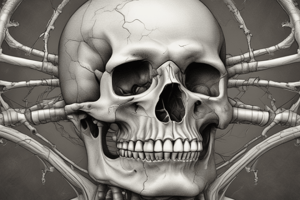Podcast
Questions and Answers
What is a distinguishing feature of osteoid osteoma compared to osteoblastoma?
What is a distinguishing feature of osteoid osteoma compared to osteoblastoma?
- It arises from the diaphysis of long bones.
- It is larger than 2 cm in size.
- It responds to aspirin for pain relief. (correct)
- It occurs primarily in children under 12.
Which characteristic is associated with Ewing sarcoma?
Which characteristic is associated with Ewing sarcoma?
- Peak incidence in elderly patients.
- Onion-skin appearance on x-ray. (correct)
- Small, round blue cells resembling reticulocytes on biopsy.
- Arises in the metaphysis of long bones.
In which area is osteosarcoma most likely to arise?
In which area is osteosarcoma most likely to arise?
- Diaphysis of long bones.
- Metaphysis of long bones. (correct)
- Surface of facial bones.
- Epiphysis of long bones.
What is a clinical characteristic of giant cell tumor?
What is a clinical characteristic of giant cell tumor?
Which of the following bone tumors is most commonly associated with Gardner syndrome?
Which of the following bone tumors is most commonly associated with Gardner syndrome?
Which of the following statements about osteochondroma is correct?
Which of the following statements about osteochondroma is correct?
Which population is most commonly affected by Ewing sarcoma?
Which population is most commonly affected by Ewing sarcoma?
Which type of bone tumor has an associated radiographic finding of a 'Codman triangle'?
Which type of bone tumor has an associated radiographic finding of a 'Codman triangle'?
Flashcards
Osteoid Osteoma
Osteoid Osteoma
A benign tumor of bone cells (osteoblasts) producing osteoid. Occurs in young adults and presents with painful bones that feel better with aspirin.
Osteochondroma
Osteochondroma
A benign tumor of bone with a cartilage cap, often growing from the growth plate of long bones. It's the most common benign bone tumor.
Osteosarcoma
Osteosarcoma
A malignant tumor of bone, often affecting teenagers. It can be associated with inherited disorders and radiation exposure. It presents with painful bone swelling and may cause fractures.
Giant Cell Tumor
Giant Cell Tumor
Signup and view all the flashcards
Ewing Sarcoma
Ewing Sarcoma
Signup and view all the flashcards
Chondroma
Chondroma
Signup and view all the flashcards
Chondrosarcoma
Chondrosarcoma
Signup and view all the flashcards
Osteoma
Osteoma
Signup and view all the flashcards
Study Notes
BONE TUMORS
-
Osteoma:
- Benign bone tumor
- Commonly found on facial bones' surfaces
- Associated with Gardner syndrome
-
Osteoid Osteoma:
- Benign tumor of osteoblasts
- Develops in young adults (primarily males)
- Arises within the cortex of long bones (e.g., femur)
- Characterized by bone pain relieved by aspirin
- Imaging shows a bony mass (less than 2 cm) with a radiolucent core (osteoid)
-
Osteoblastoma:
- Similar to osteoid osteoma, but larger (> 2 cm)
- Primarily found in vertebrae
- Bone pain not relieved by aspirin
-
Osteochondroma:
- Benign bone tumor with a cartilage cap
- Most common benign bone tumor
- Originates from growth plate projections (metaphysis)
- Bone is continuous with marrow space
- Cartilage cap can rarely develop into chondrosarcoma
-
Osteosarcoma:
- Malignant tumor of osteoblasts
- Most common in teenagers, less common in elderly
- Risk factors: retinoblastoma, Paget's disease, radiation
- Develops in the metaphysis of long bones (typically distal femur or proximal tibia)
- Presents with pathologic fractures or bone pain and swelling
- Imaging: destructive mass with "sunburst" appearance and lifting of periosteum (Codman triangle)
GIANT CELL TUMOR
- Tumor of multinucleated giant cells and stromal cells
- Occurs in young adults
- Develops in epiphysis of long bones (typically distal femur or proximal tibia)
- X-ray appearance: "soap-bubble"
- Locally aggressive, prone to recurrence
EWING SARCOMA
- Malignant tumor of neuroectoderm
- Usually affects male children under 15
- Originates in the diaphysis of long bones
- X-ray appearance: onion-skin
- Biopsy shows small, round blue cells resembling lymphocytes
- Often confused with lymphoma or chronic osteomyelitis
- t(11;22) translocation characteristic
- Responsive to chemotherapy, often present with metastases
CHONDROMA
- Benign tumor of cartilage
- Typically found in small bones of hands and feet
CHONDROSARCOMA
- Malignant cartilage-forming tumor
- Develops in the medulla of pelvis or central skeleton
METASTATIC TUMORS
- More prevalent than primary tumors
- Often result in osteolytic lesions (punched-out areas)
- Prostatic carcinoma commonly produces osteoblastic lesions.
Studying That Suits You
Use AI to generate personalized quizzes and flashcards to suit your learning preferences.




